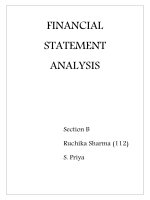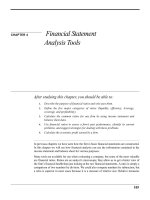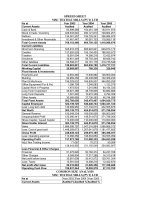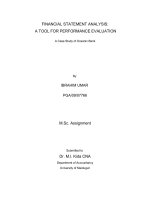FINANCIAL STATEMENT ANALYSIS
Bạn đang xem bản rút gọn của tài liệu. Xem và tải ngay bản đầy đủ của tài liệu tại đây (389.9 KB, 133 trang )
FINANCIAL STATEMENT ANALYSIS
TABLE OF CONTENTS
SERIAL NO TITLE PG.NO
CHAPTER – I INTRODUCTION 2 - 8
CHAPTER – II AQUACULTURE 9-19
CHAPTER – III SHRIMP AND PRAWN CULTURE 20-29
CHAPTER – IV AQUACULTURE BUSINESS 30-42
CHAPTER – V SOUTHERN INDIA AQUACULTURE 43- 56
CHAPTER – VI FINANCIAL STATEMENT ANALYSIS 57- 94
CHAPTER – VII RATIO ANALYSIS IN SIAC 95-110
CHAPTER - VIII CONCLUSION 111- 118
CHAPTER-IX FINDINGS AND SUGGISTIONS
1
CHAPTER – I
INTRODUCTION
CONTENTS:
Introduction
Significance of the Study
Objectives of the Study
Nature and Importance of Study
Methodology
Limitations
2
INTRODUCTION
Ratio analysis is a powerful tool of financial analysis. A ratio is defined as
the indicated quotient of two or more things. In financial analysis, a ratio is used
as an index or yardstick for evaluating the finical position and performance of firm.
The absolute accounting figures reported in the financial statements are not
providing a meaningful understanding of the performance and financial position of
a firm. Accounting figures conveys meaning when it is related to some other
relevant information. “The relationship between two accounting figures, expressed
mathematically” is known as financial ratio. A ratio helps the analysis to make
qualitative judgment about the firm’s financial performance.
A Ratio analysis is defined as the systematic use of ratio to interpret the
finical statement so that the strength and weakness of a firm as well as its historical
performance and current financial conditions can be determined. Another Factor
responsible for high level of working capital is that the repair and maintenance of
work under taken in the off seasons. The present study undertaken with the
aspiration of that it would be useful in maintaining us components of ratio analysis
management of “Southern India Aquaculture” Company, Chennai. Aquaculture
can be conducted profitably in a wide variety of conditions and environments. The
choice of production system and crop product for your project is affected by local
conditions, such as water availability and quality, site topography and climate.
Aquaculture is a capital-intensive venture. Capital is required for construction of
ponds, water system, aeration system, operational equipment, etc. The investment
and economic projections are analyzed by APT( Aquaculture Production
Technology ) in a Business Plan, which is key to raising project financing.
3
SIGNIFICANCE OF THE STUDY
In a perfect world there would be no necessity for current liabilities and
current assets because there would be no uncertainty no transaction costs
information search costs or production and technology constraint. However the
world on which we live is not perfect.
So organization may be faced with on an uncertainty regarding availability
of sufficient quantity of critical inputs in future of reasonable price. This may
necessitate the holding of critical inputs in future of reasonable price this may
necessitate the holding of critical inputs in future of reasonable price. This may
necessitate i.e., Current Assets.
To ensure that each of the Current Assets is efficiently managed to ensure
the overalls liquidity of the unite and at the same time not keeping too high a level
of any one of the working capital management is must.
Working Capital attains a proper balance between the amount of current
liabilities in such a way that firm is always able to meet its financial obligation
whenever due.
Working Capital ensures smooth working of the unit without any production
help ups due to the paucity of the funds.
4
OBJECTIVES OF THE STUDY
• To determine the trends in Working Capital Components. So as to find the
inference of each component on working capital of the firm.
• To determine the working capital position in the organization by interpreting
various ratios like working capital turnover ratio, creditor’s turnover ratio
debtors turnover ratio and liquidity ratio.
• To stuffy the liquidity solvency and capability position of Southern India
Aquaculture Company, Chennai.
• To offers suggestion for the improvement of financial position of the.
Southern India Aquaculture. To indicate the direction of change and reflect
whether the firm’s financial performance has improved deteriorated and or
remained constant over time.
• Provide management with financial information to be able to spot out
financial weakness of the firm to take suitable corrective action.
5
NATURE AND IMPORTANCE OF STUDY
To carry business activity the prime requirement is “Capital” required for a
business can be classified under two categories viz., fixed capital, and working
capital.
Every business needs funds for two purposes for its establishments and
carryout its day- to- day operations. Long term funds are required to create
production facilities through Fixed Assets Such as plant, machinery, Land
Buildings, Furniture and Fixtures etc.,
An Investment in these assets represents that past of firm capital which is
blocked on a permanent basis is called “Fixed Capital”.
Funds are also needed for short term purposes like purchase of raw
materials, payment of wages and other day - to – day expenses etc.,
6
METHODOLOGY
Methodology is a procedure in the project report has been carried out two
important sources of methodology.
1. Primary.
2. Secondary.
Primary data has been carried out through study specially designed to fulfill the
data needs of problem at hand, the data has been collected through direct personal
interview and indirect oral interview. During the study opinion and views of the
various departmental heads were taken into consideration.
Secondary Data has been collected from published sources like post records,
Journals, Magazines …etc., the main source for analyzing of profitability and
financial position of Southern India Aquaculture Company, Chennai.
7
LIMITATIONS
The present study in carried out basing on the financial statements provided
by the form for last five years of the firm.
• Since it is a large organization and the time period is just two months it is
very difficult to get clear picture.
• Analysis is based on ratio and other financial statements calculated and
hence the subjective matter of the company must have been ignored.
• It is the outcome of the accounting concepts and conventions with personal
judgments.
• Lack information and communication there is some defaults will arise while
showing the overall profitability of organization.
• The information is historical in nature.
• Lack of information and Communication there is some defaults will arise
while presenting origin of Southern India Aquaculture.
• The Limitations of ratio analysis are applicable to the study also.
• Through the primary data or collected but secondary data plays much role.
8
• Calculate ratios may not be future indicators.
CHAPTER – II
AQUACULTURE
CONTENTS:
Introduction
History
Definition
Production Volume
Fish Culture Practice
Top Ten Aquaculture Producers
Economy of Fish Culture
Problems with Fish Culture
Fish Culture in Future
Department of commerce and NOAA National Aquaculture Policies
9
INTRODUCTION
Aquaculture, also known as aqua farming, is the farming of aquatic
organisms such as fish, crustaceans, mollusks and aquatic plants. Aquaculture
involves cultivating freshwater and saltwater populations under controlled
conditions, and can be contrasted with commercial fishing, which is harvesting for
wild fish.
HISTORY:
1 Aquaculture was operating in china circa 2500 BC. Early aqua culturists fed
their brood using nymphs and silkworm feces, and ate them.
2 Japanese cultivated seaweed by providing bamboo poles and, later, nets and
oyster shells to serve as anchoring surfaces for spores.
3 Aquaculture spread in Europe during the Middle Ages, since away from the
seacoasts and the big rivers, fish were scarce and expensive.
4 Improvement in transportation during the 19
th
century made fish easily
available and inexpensive.
5 In 1864 Seth Green had established a commercial fish hatching operation at
Caledonia springs, near New York.
6 In 1866, artificial fish hatcheries were under way in both Canada and United
States. In 1889, Dildo Island fish hatchery opened in New found land, it was
10
the largest and most advance in the world.
DEFINITION:
“Aquaculture is nothing but farming of aquatic organisms including fish,
mollusks, crustaceans and aquatic plants”. Farming implies individual or corporate
ownership of the stock being cultivated.
PRODUCTION VOLUME:
In 2004, the total world production of fisheries was 140 million tones
of which aquaculture contributed 45 million tones, about one third. The growth
rate of worldwide aquaculture has been sustained and rapid, averaging about 8 %
per annum for over thirty years, while the take from wild fisheries has been
essentially flat for the last decade. The Aquaculture market reached $ 86 billion in
2009.
Aquaculture is an especially important economic activity in china. Between 1980
and 1997, the Chinese Bureau of Fisheries reports, aquaculture harvests grew at an
annual rate of 1.67 %. In 2005, China accounted for 70 % of world production.
Aquaculture is also currently one of the faster growing areas of food production in
the U.S. Approximately 90% of all U.S shrimp consumption is farmed and
imported.
11
FISH CULTURE PRACTICE
Fish culture is practiced in less than 30 percent of the total areas available.
This has a potential to create huge job opportunities, provided fish cultivation is
done on a scientific basis India is a large producer of inland fish, ranking next only
to Japan. With an abundance of freshwater resources, India has still not been able
to tap even 30% of the potential area for inland fish production. Many
entrepreneurs have, however, chosen to take this occupation on commercial scale.
This is best manifested in Andhra Pradesh, which with 10, 56,000 tons of inland
fish production in 2007-08 ranked next only to West Bengal, which is far more
endowed with water resources. Andhra Pradesh has emerged among the ranks
encouraging farmers to form cooperatives to take up farming in ponds around
Kolleru Lake. Both the central and state governments have come up with schemes
to help the cause of the farmers.
FISH CULTURE IN PONDS
Out of the total inland fish production of over 3.6 million metric tons, more
than 60% is contributed by fish culture in ponds and reservoirs. The average
productivity from ponds on the national level is around 2,500 kg/ha/year, though in
Andhra Pradesh and Haryana it is more than 5,000 kg/ha/year, while in some other
states like Bihar and UP it is anywhere between 1,500 and 2,500 kg/ha/year. Fish
culture is adopted by all kinds of farmers – small and marginal ones, relatively
larger farmers and those who do it on commercial scale. Sizes of ponds also
depend on how affluent the farmers are. Ponds less than 100 square meters in area
prove unsustainable, while those above 1 hectare are expensive for small players.
Many farmers in Tamil Nadu, for instance, use ponds of sizes 30 feet by 30 feet to
12
make their living. On the other hand, water spread of anything less than 10
hectares in Andhra Pradesh is treated as a pond.
FISH SPECIES BRED IN PONDS:
Ponds can be perennial or seasonal. While seasonal ponds can be used for
short-term fish culture, provided they retain water for at least four to five months,
perennial ponds are suited for fish culture on a larger scale. Since water dries up in
a few months, seasonal ponds are easy to harvest fish. Any perennial pond
retaining water depth of 2 meters can be used for fish culture. Dr Gopinath Sai,
executive director (technical), National Fisheries Development Board (NFDB),
says a water level of 3 to 4 feet is preferable, even in summer.
Fish farming can be practiced on scientific lines in perennial ponds only,
though seasonal ponds can be used to cultivate fry. Though different pond shapes
are being adopted by farmers, rectangular ponds are easier to work on, Sai points
out. He says freshwater fish culture is a very profitable business provided farmers
take up this on scientific lines. Quality of soil, water, and fish seed and fish food
needs to be of reasonably good quality to have better yields. The soil for ponds
should be able to retain water, and hence clayey soil is preferable.
The water should not be acidic in nature, nor should it be highly alkaline. It
should be treated with appropriate quantity of lime. Provision for inlets and outlets
should be made in ponds, as Sai and C Ratnamachari, joint director, Inland
Fisheries, Andhra Pradesh, says. However, Ranjit, a fish farmer from Bihar, now
into fish culture and retail trading in Delhi, says, “We do not know about any inlets
or outlets in our ponds but we manage a good catch despite that.” Ponds are not the
natural habitat of fish; it is rivers and canals. This makes it imperative for farmers
to provide food from outside and also create a desirable environment.
13
Fish food is provided in the form of oil cakes and rice bran. But to create
conditions suitable for other organisms to grow inside ponds, fertilizers need to be
applied. A combination of organic and inorganic fertilizers is ideal, Ratnamachari
says. Their application depends on the soil quality to a great extent.
3.6 million Metric tons – Annual produce of inland fish in India, 60 % come from
fish culture in ponds and reservoirs, 60 species – Cultivated in different parts of
India in ponds or reservoirs, 80 % - Contribution of carps from Fish Culture.
MAJOR SPECIES CULTURED IN PONDS:
Indian Major Carps – Rohu, Catla, and Mrigal
Exotic Carps – Silver Carp, Grass Carp, Common Carp
Cat Fish – Magur, Ari, Singhi
Tilapia - also known as Kowai.
Trout – golden mahseer, silver mahseer, silver grey mahseer, and black mahseer
14
TOP TEN AQUACULTURE PRODUCERS IN 2004
S.No Country
Million
tonnes
1 China 30.61
2 India 2.47
3 Veitnam 1.2
4 Thailand 1.17
5 Indonesia 1.05
6 Bangladesh 0.91
7 Japan 0.78
8 Chile 0.67
9 Norway 0.64
10 United states 0.61
11
Other
countries 5.35
Total 45.46
ECONOMIES OF FISH CULTURE IN PONDS (FOR 1 HA, UP TO 1M
EXCAVATION):
Economics of Fish Culture in Ponds (for 1ha, up to 1m excavation)
Items
Amount (in
Rs)
15
A. Fixed costs
Excavation of one hectare land (10,000 cubic meter land to the
depth of one meter @Rs 20/cubic meter
200000
Construction of inlet and outlet to ponds 40000
Equipment and gears 15000
Total fixed costs 255000
B. Recurring costs
Lime 500 kg @ Rs 7/kg 3500
Fingerlings 5,000 in number @ Rs 600 for every 1000 3000
Organic manure (cow dung) 15 tons @ Rs 400/ton 6000
Urea 330 kg @ Rs 7/kg 2310
Super phosphate 165 kg @ Rs 6/kg 990
Ammonium sulphate 63 kg @ Rs 6/kg 378
Mustard oil cake 1350 kg@Rs 12/kg 16200
Rice bran 1350 kg @ Rs 4/kg 5400
Insurance cost @ 4% of seed and fertilizers 1200
Miscellaneous including harvesting, security of ponds, etc. 8000
Total recurring cost 46978
Total cost 301978
Income
Production (from second year onwards ) (in kg) 3000
Sale price (per kg) 45
Total Income (from second year onwards) (in Rs) 135000
Net income for first seven years
Net Income in first year -301978
Net Income in second year 88022
Net Income in third year 88022
Net Income in fourth year 88022
Net Income in fifth year 88022
16
Net Income in sixth year 88022
Net Income in seventh year 88022
Source: Updated from NABARD
Rajat Sharma of Haryana Fisheries Department has a simple mathematics
for fish farming, which he says is followed by most fish farmers in the state. He
says what is needed to produce for 1 kilogram of fish is 1 cubic meter water, 1
kilogram of organic manure, 100 grams of inorganic fertilizer, 1 kilogram of
supplementary feed and three fish seeds. Farmers, he says, should wait for one
year for the fish to mature. According to his calculation, investment needed for 1
kilogram of fish is anywhere between Rs 15 and 25.
The sale price of 1 kilogram of fish to wholesalers is anywhere between Rs
40 and 50, ensuring more than double the income. Being a state subject, the
fisheries department also helps farmers get the right quality fingerlings. Private
hatcheries have also come up in several parts of the country and government
schemes are also aiding this process. Fingerlings must be free from disease because
one infected fish may cause widespread damage. Polyculture in ponds is the
dominant production system in most parts of the country. Carps, both Indian and
exotic, contribute to almost 80% of the produce from ponds. Rohu, katla, mrigal
and magur are the favorite pond fish varieties.
PROBLEMS WITH FISH CULTURE
“The biggest problem with fish culture is the possibility of diseases,” Sai
points out. Fish can be infected with fungal, bacterial, ulcer or worm diseases. It is,
however, easy to spot infected fish as they become weak and lethargic, and often
come to the surface of the water to breathe. In eye diseases, for instance, their eyes
17
become opaque. Infected fish can have open spores on the body, and can also have
their scales dropping, something Ranjit says caused him huge losses when he used
to cultivate fish. Treatments are available in the form of treating the water with
potassium permanganate solution, or with acetic acid and normal salt. Copper
sulphate solution and chloromycetin are also used to treat some other diseases. Any
unusual feeding behavior of fish should be taken seriously. It is best to prevent
diseases, as once infected; the fish population in a pond can be wiped out, causing
big losses of both money and time for farmers. Another problem area can be
marketing. Fish procured from ponds are perishable goods. To keep the stock fresh
and fit enough to be sold in markets, suitable ice containers and cold storages are
essential. It is also mandatory to have good transportation links to main wholesale
markets.
THE FUTURE
The central government has come up with schemes in association with state
governments from time to time to support fish culture. Development of Inland
Fisheries and Aquaculture was one such scheme launched during the 10th Plan.
Under the scheme, whose cost is borne by the central and the state governments in
the ratio of 75:25, farmers are given assistance for building ponds. A subsidy of
20% is given assuming cost for constructing a pond in plain areas is Rs 200,000
per hectare and at Rs 300,000 per hectare in hilly regions. For people from
scheduled castes and scheduled tribes subsidy is a little higher at 25%. If an
existing pond is to be renovated, subsidy is given at 20% assuming cost of Rs
60,000 per hectare.
18
The National Bank for Agriculture and Rural Development (NABARD) also
refinances the banks extending loans to fisheries cooperatives or to entrepreneurs
involved in fish culture. The formation of the Fish Farmers’ Development
Agencies (FFDAs) was another major scheme launched by the Ministry of
Agriculture in the 1970s. These agencies provide financial, technical and other
support to beneficiaries at district level throughout India. Training is also provided
through the NFDB. Sai says that the NFDB conducts training for officials from
fisheries departments and various NGOs involved with fish farmers. They pass
knowledge gained on to the farmers in the field.
India produces in excess of 3.6 million metric tons of freshwater fish, but a
lot of potential lies untapped. While the area covered by rivers cannot be added,
fish production through ponds can definitely be increased by several notches.
Fortunately, the stakeholders in the fish business realize this. India has, therefore,
fixed a target of over 5.5 million metric tons of freshwater fish catch by 2020.
However, more capital investment and technological knowledge is required. There
is a need for better resource management and community intervention in all places
where fish culture is practiced or can be practiced. Rain-fed areas should also be
utilized to cultivate fish. As far as markets are concerned, communication systems
among fishermen’s cooperatives controlling marketing need to be enhanced. This
would be beneficial not only for farmers, but also for consumers.
DEPARTMENT OF COMMERCE AND NOAA NATIONAL
AQUACULTURE POLICIES:
19
On June 9, 2011, NOAA and the Department of commerce released final
national aquaculture policies. These policies establish a framework to allow
sustainable domestic aquaculture to contribute to the U.S. seafood supply, support
coastal communities and important commercial and recreation fisheries, and help
to restore species and habitat. NOAA sees aquaculture as a critical component to
meeting increasing global demand for seafood and maintaining healthy
ecosystems.
CHAPTER – III
SHRIMP AND PRAWN CULTURE
CONTENTS:
Introduction
History of shrimp culture
Economy
Hatchery training in India
20
Feeds
Feed ingredients
Feeding practices
Summary
SHRIMP AND PRAWN CULTURE:
INTRODUCTION:
A “shrimp farm” is an aquaculture business for the cultivation of
marine shrimp or prawns for human consumption. Commercial shrimp farming
began in the 1970s, and production grew steeply, particularly to match the market
demands of the United States, Japan and Western Europe. The total global
production of farmed shrimp reached more than 1.6 million tonnes in 2003,
representing a value of nearly 9 billion U.S. dollars. About 75% of farmed shrimp
is produced in Asia, in particular in China and Thailand. The other 25% is
produced mainly in Latin America, where Brazil, Ecuador, and Mexico are the
largest producers. The largest exporting nation is Thailand.
21
HISTORY OF SHRIMP CULTURE:
1 Indonesians and others have farmed shrimp for centuries, using traditional
low-density methods. Indonesian brackish water ponds, called tambaks, can
be traced back as far as the 15th century.
2 By the 1960s, a small industry had developed in Japan. Commercial shrimp
farming began to grow rapidly in the late 1960s and early 1970s.
3 Taiwan was an early adopter and a major producer in the 1980s; its
production collapsed beginning in 1988 due to poor management practices
and disease. In Thailand, large-scale production expanded rapidly from 1985
4 In South America, Ecuador pioneered shrimp farming, where it expanded
dramatically from 1978. Today, there are marine shrimp farms in over fifty
countries.
ECONOMY:
The total global production of farmed shrimp reached 2.5 million tonnes
in 2005. This accounts for 42% of the total shrimp production that year.
The largest single market for shrimp is the United States, importing between 500 –
600,000 tonnes of shrimp products yearly in the years 2003-2009.
About 200,000 tonnes yearly are imported by Japan, while the European Union
imported in 2006 another about 500,000 tonnes of tropical shrimps, with the
largest importers being Spain and France
The import prices for shrimp fluctuate wildly. In 2003, the import price per
kilogram shrimp in the United States was US$ 8.80, slightly higher than in Japan at
22
US$8.00. The average import price in the EU was only about US$5.00/kg.
About 75% of the world production of farmed shrimp comes from Asian countries;
the two leading nations being China and Thailand, closely followed by Vietnam,
Indonesia, and India. The other 25% are produced in the western hemisphere.
In terms of export, Thailand is by far the leading nation, with a market share of
more than 30%, followed by China, Indonesia, and India, accounting each for
about 10%. Other major export nations are Vietnam, Bangladesh, and Ecuador.
A joint programmed of the World Bank, the Network of Aquaculture Centers in
Asia-Pacific (NACA), the WWF, and the FAO was established in August 1999 to
study and propose improved practices for shrimp farming.
HATCHERY TRAINING IN INDIA:
Shrimp hatchery technology development in the Indian private sector has
been slow. Inappropriate models and concentration of effort in the public sector
were two reasons. It has been recognized that hatchery seed supply will only
increase proportionally to the degree of private investment in the industry.
Therefore, BOBP’s training programmed targeted the small-scale business
community. Advertisements placed in local and regional newspapers during
November 1991 offered training in shrimp and prawn hatchery technology. Over
300 applications were received. Of these, 22 were interviewed and ten selected,
eight of them for shrimp hatchery training and two for freshwater prawn hatchery
training. Of the successful applicants, two had some experience in shrimp culture,
while the others were small business persons, including one woman.
Geographically, most applications were received from Tamil Nadu, followed by
23
Andhra Pradesh, Orissa and West Bengal Of the successful applicants, six were
from Tamil Nadu, two from Andhra Pradesh and one each from Orissa and West
Bengal. The candidates from Orissa and West Bengal were selected for freshwater
training.
The National Prawn Fry Production and Research Center (NAPFRE), Pulau Sayak,
Malaysia, was selected as the training site for the eight shrimp hatchery
participants. NAPFRE regularly conducts international training courses, has a well
trained and experienced staff and has good accommodation facilities. The
curriculum included all aspects of tiger shrimp hatchery operation. The training
period was for 31 days, June 7 - July 7 1992, and included field visits to small
scale commercial hatcheries (see Appendix I for curriculum).
The participants from Orissa and West Bengal were trained in freshwater prawn
hatchery technology for 35 days during 1993. In addition, two biologists from the
Department of Fisheries (DOF) hatchery in Cuttack, Orissa, completed a 10-day
short course in June 1993 (see Appendix II for curriculum). Asia is the principal
producer of farmed shrimp, accounting for 81 percent of the total world production
of about 600,000.
ASIAN SHRIMP CULTURE PRODUCTION, 1992
% No of Farms
Thailand 25.4 14,000
China 23.7 3,000
Indonesia 22 15,000
India 7.6 1,500
Viet Nam 5.9 1,000
Taiwan 5.1 2,500
24
Philipines 4.2 3,000
Bangladesh 4.2 6,000
Malaysia 0.6 350
Japan 0.5 150
Others 0.8 440
Total 100 46,940
FEEDS:
Natural food items: Zooplankton and oligochaete worms play a very important role
in the nutrition of freshwater prawns grown in ponds. Even juveniles larger than 2g
can utilize live zooplankton. Earthworm and insect larvae are also natural food
items for the prawns. Enhancement of macroinvertebrate production in ponds is
extremely important in the production of freshwater prawns as it would improve
feed efficiency considerably. The use of good quality feeds, however, is important
when biomass in the ponds increase as the animals grow. Moreover, more uniform
production of large prawns is achieved when feeds are used
FEED INGREDIENTS:
Prawn head meal, chicken offal, clam meat, silk worm pupae, meat and bone
meal, fish meal, crustacean meal, squid meal and mussel meat meal are some of the
excellent ingredients used in prawn feed trials. Various cereal grains, oil seed
cakes (ground nut oil cake, soybean cake, and sunflower oil cake), rice bran and
several other animal husbandry and agro by-products available have also been used
25









